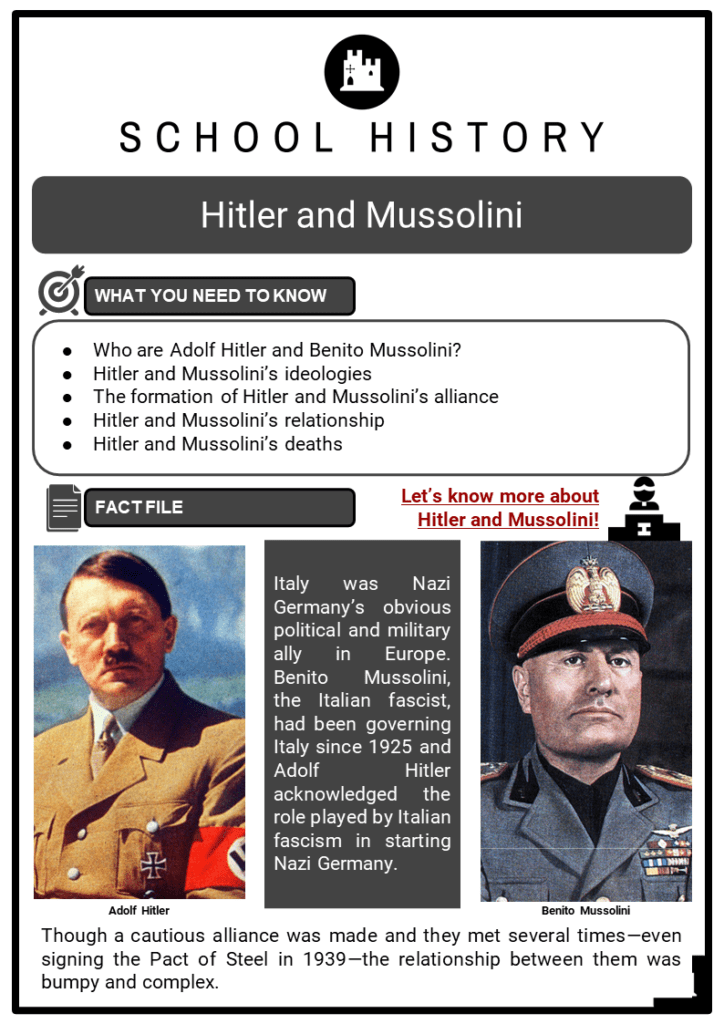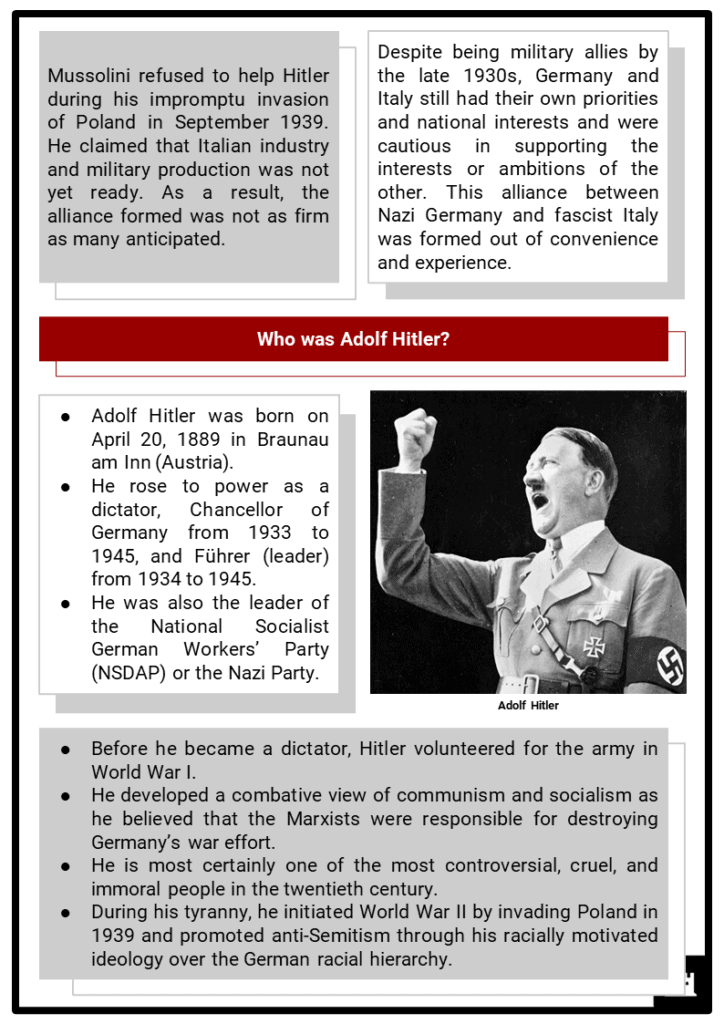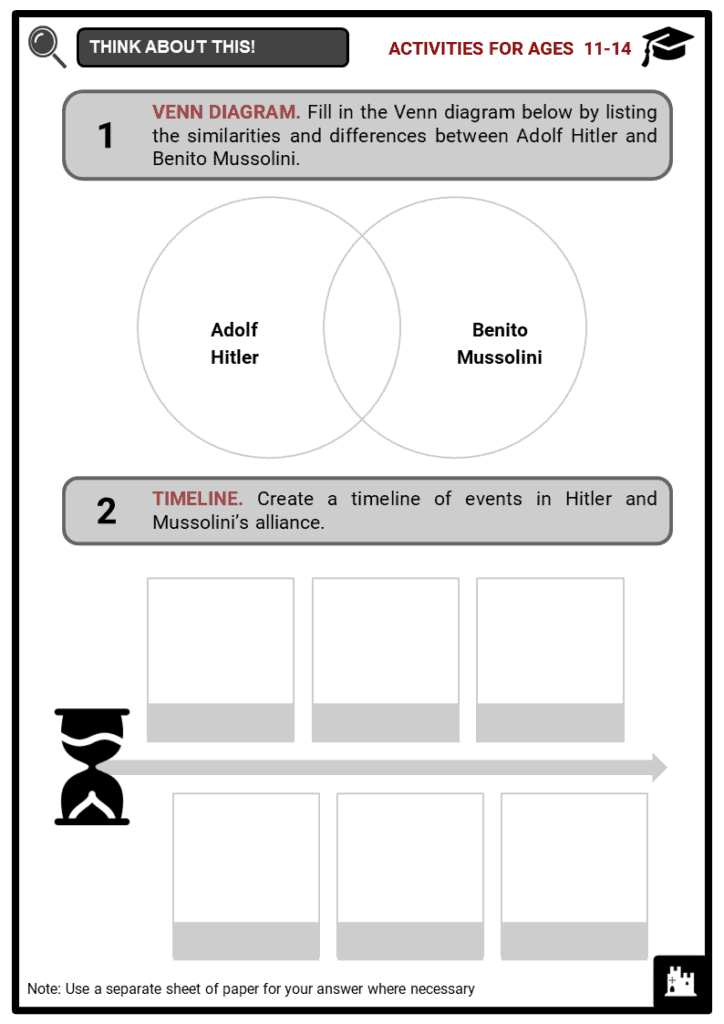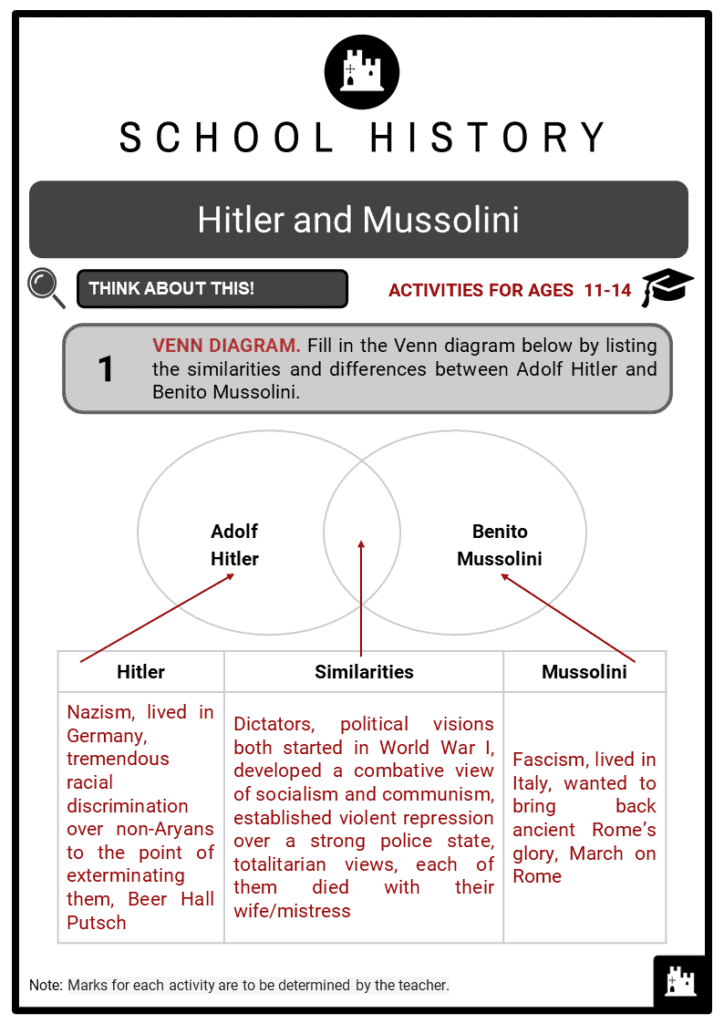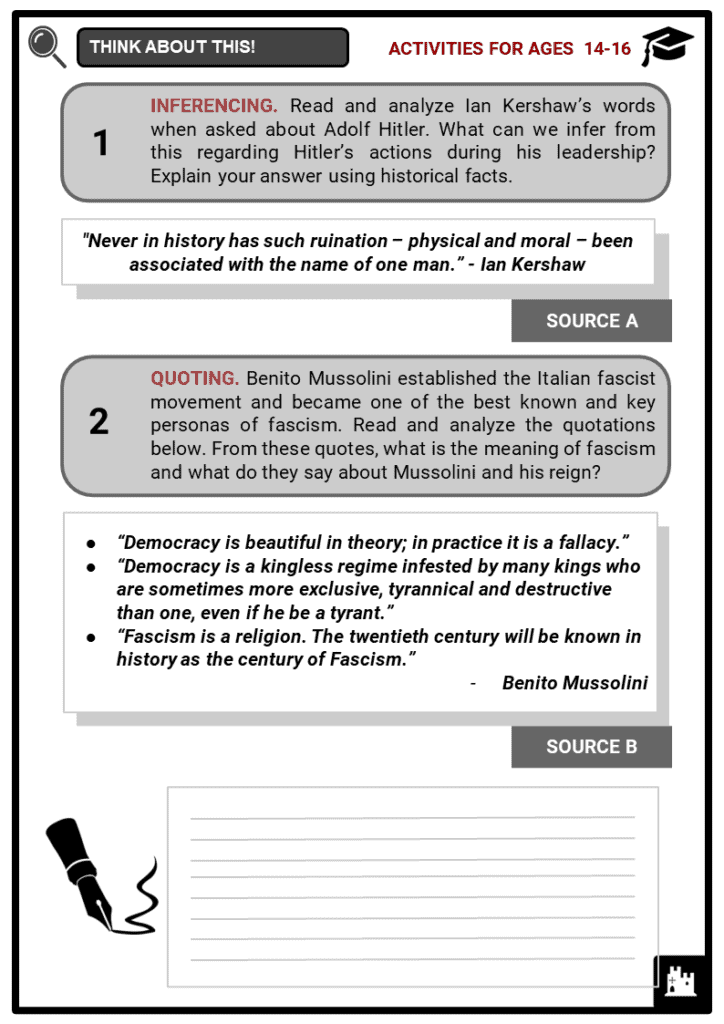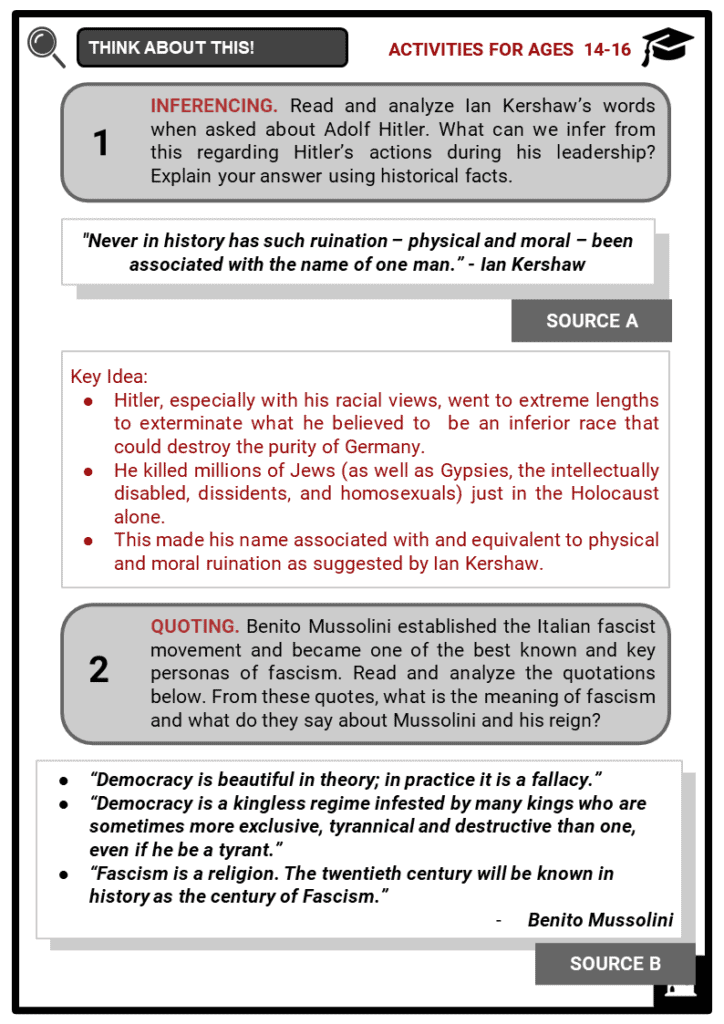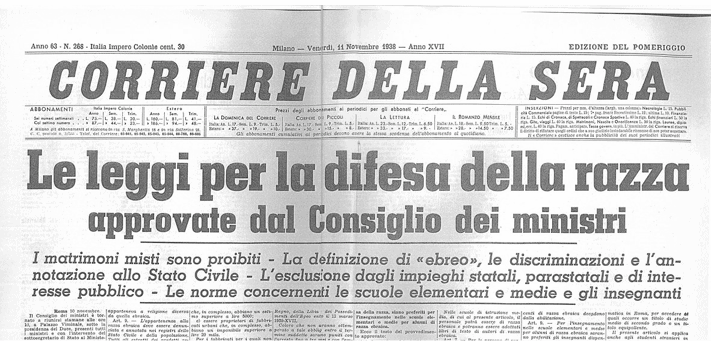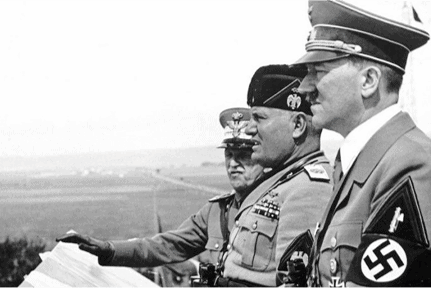Download Hitler and Mussolini Worksheets
Do you want to save dozens of hours in time? Get your evenings and weekends back? Be able to teach Hitler and Mussolini to your students?
Our worksheet bundle includes a fact file and printable worksheets and student activities. Perfect for both the classroom and homeschooling!
Table of Contents
Add a header to begin generating the table of contents
Summary
- Who are Adolf Hitler and Benito Mussolini?
- Hitler and Mussolini’s ideologies
- The formation of Hitler and Mussolini’s alliance
- Hitler and Mussolini’s relationship
- Hitler and Mussolini’s deaths
Key Facts And Information
Let’s know more about Hitler and Mussolini!
- Italy was Nazi Germany’s obvious political and military ally in Europe. Benito Mussolini, the Italian fascist, had been governing Italy since 1925 and Adolf Hitler acknowledged the role played by Italian fascism in starting Nazi Germany.
- Though a cautious alliance was made and they met several times—even signing the Pact of Steel in 1939—the relationship between them was bumpy and complex.
- Mussolini refused to help Hitler during his impromptu invasion of Poland in September 1939. He claimed that Italian industry and military production was not yet ready. As a result, the alliance formed was not as firm as many anticipated.
- Despite being military allies by the late 1930s, Germany and Italy still had their own priorities and national interests and were cautious in supporting the interests or ambitions of the other. This alliance between Nazi Germany and fascist Italy was formed out of convenience and experience.
Who was Adolf Hitler?
- Adolf Hitler was born on April 20, 1889 in Braunau am Inn (Austria).
- He rose to power as a dictator, Chancellor of Germany from 1933 to 1945, and Führer (leader) from 1934 to 1945.
- He was also the leader of the National Socialist German Workers’ Party (NSDAP) or the Nazi Party.
- Before he became a dictator, Hitler volunteered for the army in World War I.
- He developed a combative view of communism and socialism as he believed that the Marxists were responsible for destroying Germany’s war effort.
- He is most certainly one of the most controversial, cruel, and immoral people in the twentieth century.
- During his tyranny, he initiated World War II by invading Poland in 1939 and promoted anti-Semitism through his racially motivated ideology over the German racial hierarchy.
- He, together with the Nazis, was responsible for the Holocaust: “the ideological and systematic state-sponsored persecution and mass murder of millions of European Jews (as well as Gypsies, the intellectually disabled, dissidents, and homosexuals) by the German Nazi regime” (History Editors 2020).
- With his strong state police, he was able to inflict fear and gain support from the Germans. His ideologies, embodied in the Nazi Party, were regarded as gravely immoral to such a point that Ian Kershaw said: "Never in history has such ruination – physical and moral – been associated with the name of one man."
Who was Benito Mussolini?
- Benito Amilcare Andrea Mussolini was born on July 19, 1883 in Predappio, Italy.
- He was the leader of the National Fascist Party and the Italian Prime Minister from 1922 to 1943.
- On January 3, 1925, he asserted the right to supreme power and became dictator and Il Duce (the leader) of Italy.
- Before he became a dictator, he was a political journalist in World War I. He developed a negative view towards socialism and communism as he blamed them for prioritizing class distinctions over unity of the nation during the war.
- During his dictatorship, he established the Italian fascist movement and became one of the best known and key personas of fascism.
- His first act was to “demand special emergency powers allowing him to rig elections in the Fascists’ favor” (History Editors 2020).
- Afterwards, he imprisoned anti-Fascists, arrested all Communist and Socialist Parliament members, and screened government propaganda with the help of his strong police state.
- Throughout his tyranny, he and his followers with their combined powers created a series of laws that converted the entire nation of Italy into a one-party dictatorship.
Formation of the Alliance
- Hitler was a great admirer of Mussolini, especially in his early years as leader of the Nazi Party.
- Hitler especially admired Mussolini’s ‘March on Rome’—a protest in 1922 that saw thousands of fascists and fascist supporters walk to the Italian capital in order to force Mussolini’s appointment as prime minister.
- The protest succeeded and Mussolini became prime minister.
- Hitler first wrote to Mussolini about the ‘March on Rome’ in 1923.
- In an attempt to emulate Mussolini, Hitler staged the Beer Hall Putsch.
- The Nazis were also given some financial support by Mussolini from the late 1920s.
- The Sturmabteilung, which was a paramilitary wing of the Nazi party, benefited from this as their brigade was allowed to train with Mussolini’s own paramilitary brigade—the Blackshirts.
- When Hitler finally ascended into power in the 1930 German election, he was publicly praised by Mussolini, who hailed it as a victory for his own fascist ideology and he began giving Hitler advice on tactics.
- This was just for the cameras, though, because in private Mussolini criticized Hitler and his party.
- He described them as “boring” because of their “unrefined” and “simplistic” ideas.
- Mussolini was known to be self-obsessed and an egomaniac.
- He also thought that his ascension to power was more glorious than Hitler’s.
- The first meeting between Mussolini and Hitler in Venice in June 1934 was a disaster.
- Mussolini showcased his arrogance as his German was not fluent, but he refused to use a translator.
- Out of pride, he refused to admit that due to Hitler’s heavy Austrian accent, he could not fully understand what he was saying.
- Hitler engaged in long monologues, and Mussolini soon became bored.
- This meeting only served to worsen the relationship between them, even though Nazi and Italian fascist propaganda of the 1930s suggested a close working relationship.
- They also had different views on race.
- Both considered white Europeans as the founders of civilization and culture, but they differed on anti-Semitism and eugenics.
- Mussolini was an Italian nationalist who usually glorified ancient Rome for its triumphs.
- He was, therefore, conservative of Hitler’s belief in Aryan supremacy. He took a swipe at the Nazis in one of his speeches describing it as a “pity” how the Nazis expressed their racial views since the Germans were “the descendants of those who were illiterate when Rome had Caesar, Virgil, and Augustus”.
- Out of convenience, Hitler and Mussolini managed to put their differences aside and a degree of co-operation was achieved.
- In the Abyssinian crisis of the mid-1930s, Germany offered support to Rome.
- Mussolini wanted to replicate the glory of ancient Rome by building a new Italian empire.
- To kickstart his vision, he wanted to conquer Abyssinia (modern-day Ethiopia), one of the few African kingdoms not yet under European control.
- In October 1935, Italian troops invaded and occupied much of Abyssinia, much to the disapproval of the League of Nations.
- Hitler, who had pulled out of the League of Nations in 1933, backed Mussolini’s actions.
- German-Italian relations were further improved by their joint involvement in the Spanish Civil War in 1936.
- In January 1936, Mussolini told a German envoy how Nazi Germany and fascist Italy shared ‘a common destiny’ and later in November he changed his view on Hitler and Germany.
- Mussolini described them as the ‘axis’ around which Europe would revolve.
- When visiting Germany in September 1937, Mussolini was greeted with a long parade of troops, artillery, and military equipment.
- This show of German might was obviously a set up to impress the Italian leader, and it worked.
- Two months later, Italy joined Germany and Japan in the Anti-Comintern Pact, which was an agreement to resist the expansion of the Soviet Union and control the spread of communism through invading Austria in March 1938.
- After this invasion, Germany had become the dominant partner in the relationship as the German army was perched on the Italian frontier.
- The alliance was bolstered by Mussolini’s ‘Manifesto of Race’ signed on July 1938.
- Hitler’s influence on Mussolini had grown a great deal. In this largely unpopular manifesto, the government stripped Italian Jews of their citizenship and ensured that Jews did not hold any government positions.
- Mussolini was part of the four-nation summit held in Czechoslovakia that aimed to resolve the crisis, and the Munich Agreement was signed in September 1938.
- To return the favour, Hitler visited Rome on May 3, 1939, accompanied by Nazi officials Joseph Goebbels and Joachim von Ribbentrop.
- They were also accompanied by five hundred party officials, diplomats, security guards, and journalists in three trains. As a token of appreciation of his previous visit, Mussolini had a special station built for the Germans.
- On arrival, they were greeted by Mussolini and King Victor Emmanuel.
- Mussolini outdid himself. Rome was adorned with decorations including swastikas (the Nazi party’s official symbol), and a new street was named after Adolf Hitler.
- The German leader was escorted to the Quirinal Palace, where he stayed as a guest.
- The next day was dedicated to tours of Rome, followed by two private meetings between Hitler and Mussolini.
- They later reviewed the Italian fleet in Naples.
- At a state banquet on May 8th, Hitler and Mussolini made speeches on German-Italian solidarity, and Hitler announced that Germany regarded the Italian frontier as ‘forever unchangeable’.
- This led to the signing of a pact of friendship in May 1939, extending the Nazi-fascist alliance between Germany and Italy.
- This pact is informally known as the ‘Pact of Steel’.
- The Pact of Steel was a ten-year agreement that committed Rome and Berlin to supply each other with military and economic aid if either nation was at war.
- Secret preparations were made in case a European war erupted, along with agreement on a rapid increase in German-Italian trade and military cooperation.
- Both nations secretly agreed to avoid waging war without the other until 1943.
- In September 1939, however, Hitler ignored this decree when he ordered German troops to invade Poland, starting the World War II.
- Mussolini informed Hitler that he would not be able to provide him with the support he needed as Italy would not be ready for war due to a decreased rate of industrial growth and military production.
- After this waiting period was over, in June 1940 Mussolini declared war and helped Germany with its conquest of Western Europe.
- Mussolini’s main war aim was to seize control of British and French colonies in northern Africa.
- Mussolini would live to regret this decision as, by late 1941, most Italian troops in Abyssinia had been defeated.
- The Allies from the West invaded Italy in July 1943, leading to the expulsion of Mussolini from power and the formation of a new government that surrendered to the Allies in September.
Hitler and Mussolini’s Deaths
- Unbeknownst to Benito Mussolini, the Nazis were already negotiating for a surrender. By April 25, 1945, the former fascist Italian dictator Benito Mussolini, with his mistress Claretta Petacci and other fascists, angrily fled north believing that they could just live in exile.
- Nonetheless, though in disguise, the propaganda which had been plastered on walls for years made his face all too familiar. They were eventually captured on April 27.
- Mussolini and others were later executed by an unknown firing squad on April 28 at Giulino di Mezzegra in northern Italy.
- Afterwards, their corpses were taken to Milan’s Piazzale Loreto where they were hung upside down, insulted, and physically abused by an angry mob of anti-fascists.
- Two days after Mussolini’s execution, Adolf Hitler committed suicide.
- The war was coming to a close and Germany was about to be defeated.
- Hitler, together with his longtime companion Eva Braun, had a civil wedding on the night of April 29, 1945 in Berlin.
- The following day, the couple committed suicide in Hitler’s bunker—Braun poisoning herself with cyanide and Hitler shooting a pistol through his temple.
- Their bodies were taken and burnt in the gardens of the Reich Chancellery, as instructed by Hitler in his last will and testament.
Image sources:
- https://upload.wikimedia.org/wikipedia/commons/thumb/9/97/March_on_Rome_1922_-_Mussolini.jpg/1200px-March_on_Rome_1922_-_Mussolini.jpg
- https://upload.wikimedia.org/wikipedia/commons/thumb/d/de/Corriere_testata_1938.jpg/1200px-Corriere_testata_1938.jpg
- https://www.thetimes.co.uk/imageserver/image/methode%2Ftimes%2Fprodmigration%2Fweb%2Fbin%2Fe4b4bef6-0b03-32c6-adf8-bdeb73291081.jpg?crop=780%2C520%2C0%2C0&resize=685

